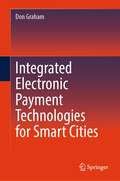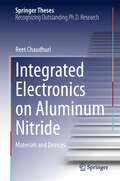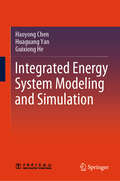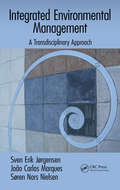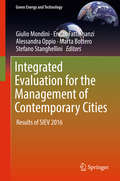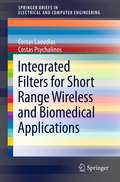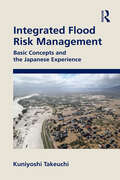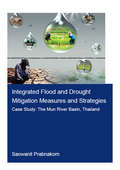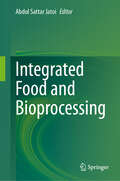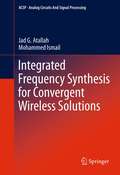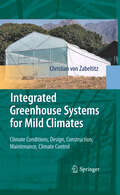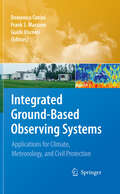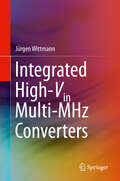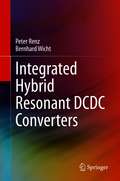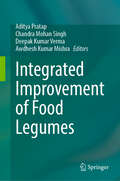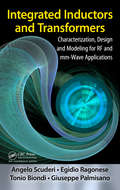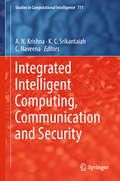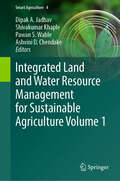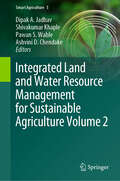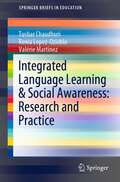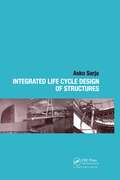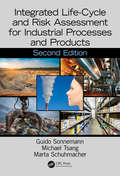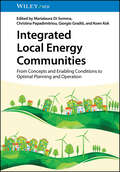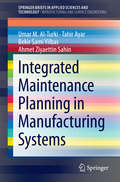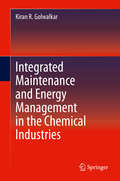- Table View
- List View
Integrated Electronic Payment Technologies for Smart Cities
by Don GrahamThis book addresses the use of existing and emerging electronic payment technologies within a smart city in the context of the clear and proven value these systems have demonstrated in improving transportation. It addresses such question as How does the toll gantry work? How does it read the transponder tag and deduct the correct amount? How do cities harness the transaction data from mass transit to better meet the demand during peak hours? What can city planners do to make trip scheduling and payments seamless, so commuters can go from park-and-ride to mass transit to ride-share with a single payment platform? The volume is technical in nature and describes solid technical solutions to engineers and planners associated with smart cities initiatives. It is specifically designed to support smart city designers and engineers as they develop strategies that incorporate the latest payment system technologies. It will also be of value to private sector payment systems solution providers looking to deliver their products and services to smart cities. In addition, the book supplements technical perspectives with guidance on planning and implementation. For example, it defines procurement approaches for emerging technologies such as crypto currencies and block chain. Rounding out technical detail with advice on policy and the organizational framework required to underpin the technologies, the book delivers practical support to smart city technical practitioners. It further stands as an appropriate text for university courses associated with smart city planning, operations, and urban analytics. This book explores these questions and provides answers that a typical transportation planner can follow. It covers technology topics such as RFID (Radio Frequency ID), ETC (Electronic Toll collection), and ANPR (Automatic Number Plate Recognition). The book also delves into how contactless payment (Near-Field) technologies can be used in a smart city. Blockchain is introduced as a platform that is suitable for solving the problem of payment segregation and shows how the entities in a smart city can work together to provide a seamless payment solution for riders across different modes of transport. The book also covers some theoretical concepts of congestion pricing which students at the university level can apply to city planning projects and research into smart cities. Several examples of US-based and international smart city implementations are provided in the closing chapters which demonstrate new, innovative smart city techniques for the transportation planner.
Integrated Electronics on Aluminum Nitride: Materials and Devices (Springer Theses)
by Reet ChaudhuriThis thesis outlines the principles, device physics, and technological applications of electronics based on the ultra-wide bandgap semiconductor aluminum nitride. It discusses the basic principles of electrostatics and transport properties of polarization-induced two-dimensional electron and hole channels in semiconductor heterostructures based on aluminum nitride. It explains the discovery of high-density two-dimensional hole gases in undoped heterojunctions, and shows how these high conductivity n- and p-type channels are used for high performance nFETs and pFETs, along with wide bandgap RF, mm-wave, and CMOS applications. The thesis goes on to discuss how the several material advantages of aluminum nitride, such as its high thermal conductivity and piezoelectric coefficient, enable not just high performance of transistors, but also monolithic integration of passive elements such as high frequency filters, enabling a new form factor for integrated RF electronics.
Integrated Energy System Modeling and Simulation
by Haoyong Chen Huaguang Yan Guixiong HeThis book provides an in-depth introduction to the dynamic characteristics of Integrated Energy Systems (IES). It establishes a unified energy network model, elucidating the complementarities between various forms of energy, the conversion efficiencies, and the interactions and influences on operating costs. The book proposes methods for the planning, configuration, and operational control of IES and develops a simulation system for the integration of multi-physical field analog, hybrid transient, and steady-state conditions. The established mathematical models and simulation system are utilized to conduct a series of analyses under typical integrated energy scenarios. These analyses evaluate the operational performance and economic benefits of IES across different conditions. This book serves as a valuable resource for professionals involved in the research, planning, design, consulting, research and development, and operation of businesses related to integrated energy systems. It also serves as an essential reference for educators and college students.
Integrated Environmental Management: A Transdisciplinary Approach (Applied Ecology and Environmental Management)
by Søren Nors Nielsen Sven Erik Jörgensen Joao Carlos MarquesBased on 40 years of experience, Integrated Environmental Management: A Transdisciplinary Approach brings together many ecological and technological tool boxes and applies them in a transdisciplinary method. The book demonstrates how to combine continuous improvement management tools and principles with proven environmental assessment methodologies
Integrated Evaluation for the Management of Contemporary Cities: Results of SIEV 2016 (Green Energy and Technology)
by Stefano Stanghellini Marta Bottero Alessandra Oppio Giulio Mondini Enrico FattinnanziThis book highlights a selection of the best papers presented at the 2016 SIEV conference “The Laudato sì Encyclical Letter and Valuation. Cities between Conflict and Solidarity, Decay and Regeneration, Exclusion and Participation”, which was held in Rome, Italy, in April 2016, and brought together experts from a diverse range of fields – economics, appraisal, architecture, energy, urban planning, sociology, and the decision sciences – and government representatives. The book is divided into four parts: Human Ecology: Values and Paradigms; Integral Ecology and Natural Resource Management; Intergenerational Equity; and How to Enhance Dialogue and Transparency in Decision-making Processes. Cities are where 72% of all Europeans live, and this percentage is expected to rise to 80% by 2050. Given this trend towards urbanization, cities are continuously growing, which also entails a growing risk of social segregation, lack of security and mounting environmental problems. All too often, today’s cities have to cope with social and environmental crises, shifting the European urban agenda towards regeneration processes. Urban regeneration is more complex than merely renovating existing buildings, as it also involves social and environmental problems, inhabitants’ quality of life, protecting tangible and intangible cultural resources, innovation and business.
Integrated Filters for Short Range Wireless and Biomedical Applications
by Costas Psychalinos Costas LaoudiasThis book describes the design of low-voltage analog integrated filters using current mirrors, one of the most common building blocks both in analog and mixed-signal VLSI circuits, offering the advantages of low-voltage operation, derivation of resistorless topologies and electronic adjustment capability of their frequency characteristics. Several design examples are described, using current mirrors that fulfill the requirements of modern low-power wireless and biomedical applications, such as universal biquadratic filter topologies, complex filters for Bluetooth/ZigBee low-IF receivers and Wavelet filters for cardiac signal detection. The experimental results from the fabricated chips will also be presented, showing their utility in modern low-voltage low-power portable devices.
Integrated Flood Risk Management: Basic Concepts and the Japanese Experience
by Kuniyoshi TakeuchiThis book tackles the question of how we can manage flood-related disaster risks, such as from typhoons, monsoons, and torrential rain, which have been intensified by climate change and have generated unprecedented floods, landslides and debris flows worldwide. It presents recent conceptual developments in disasters, risk and resilience, and surveys UN policies on environment and development as well as disaster management. Sustainable and resilient development requires an integrated approach and human empowerment. Japan provides a useful example of effective flood management and disaster recovery in its current strategies for river and basin integrated flood management. Very few English-language books present up-to-date Japanese experiences for students and professionals in the context of global trends, relevant to a time of climate change and with global application. • Outlines an integrated approach to flood risk management in the context of UN initiatives • Details Japanese good practice developed through culture and the needs of a changing society Integrated Flood Risk Management is ideal for professionals working for environmental agencies, hydrologists and engineers, as well as students of disaster management and water resources development.
Integrated Flood and Drought Mitigation Mesures and Strategies. Case Study: The Mun River Basin, Thailand (IHE Delft PhD Thesis Series)
by Saowanit PrabnakornFloods and droughts are climate extremes that account for more than 80% of people affected by natural disasters worldwide. Both catastrophes co-exist in many river basins, for example, the Mun River Basin in Thailand, which is selected as the study area. Approximately 90% of rice cultivation here is rain-fed, and that results in the lowest yields in the country, making many farmers persist in poverty. This study aims to assess floods and droughts and their impacts on agriculture at the basin scale. For flooding, the hydrologic and hydraulic models were developed to produce the first completed flood hazard maps at the Mun River Basin. Droughts in the basin were determined by the proposed drought risk assessment scheme that combines all three key components (hazard, exposure, and vulnerability). Subsequently, the study attempts to tackle both floods and droughts simultaneously and sustainably by using integrated measures and strategies. If the problems caused by flood and drought climate extremes are solved, this will ensure adequate food availability and alleviate poverty in the basin. Furthermore, the study shows that a holistic approach to simultaneously solving both problems is efficient as most water will be utilized to benefit agriculture, the primary sector that feeds a growing population.
Integrated Food and Bioprocessing
by Abdul Sattar JatoiIn a rapidly evolving world, the integration of food processing and bioprocessing technologies has become essential to meet the demands of sustainable food production, resource optimization, and environmental conservation. This groundbreaking book, Integrated Food and Bioprocessing, provides a comprehensive overview of the principles, practices, and innovations shaping the future of these interconnected fields. Key Features Include: Foundations of Integration: A detailed introduction to food engineering and bioprocessing principles. Biotechnology in Action: Insights into fermentation, enzymatic processing, and microbial applications in food systems. Innovative Solutions: Cutting-edge advancements in food preservation, waste valorization, and energy-efficient technologies. Sustainability Focus: Strategies for implementing circular bioeconomy practices and reducing environmental impact. Real-World Applications: Case studies and practical examples from diverse industries. Designed for food scientists, biotechnologists, engineers, and students, this book bridges theory and practice, offering valuable tools for addressing global challenges in food security, resource management, and climate resilience. <span lang="EN-US" style="font-size: 12.0pt; line-height: 107%; font-family: 'Times New Roman',serif; mso-fareast-font-family: Batang; mso-ansi-language: EN-US; mso-fareast-language: EN-US; mso-bidi-lang
Integrated Frequency Synthesis for Convergent Wireless Solutions
by Mohammed Ismail Jad G. AtallahThis book describes the design and implementation of an electronic subsystem called the frequency synthesizer, which is a very important building block for any wireless transceiver. The discussion includes several new techniques for the design of such a subsystem which include the usage modes of the wireless device, including its support for several leading-edge wireless standards. This new perspective for designing such a demanding subsystem is based on the fact that optimizing the performance of a complete system is not always achieved by optimizing the performance of its building blocks separately. This book provides "hands-on" examples of this sort of co-design of optimized subsystems, which can make the vision of an always-best-connected scenario a reality.
Integrated Greenhouse Systems for Mild Climates
by Christian Von ZabeltitzCrop production in greenhouses is a growing industry, especially in mild climates, and is very important for the population as a source of income and clean, fresh food. Greenhouses create optimal climate conditions for crop growth and protect crops from outside pests. At the same time greenhouse production increases water use efficiency and makes integrated production and protection (IPP) possible. This book provides technical instructions for practice (what to do and what not to do) and gives answers to the question: How to produce more clean crops and better quality with less water, less land and less pesticide. Suitable greenhouse constructions and their design, adapted to local climates in subtropical, tropical and arid regions and infrastructure conditions are presented. The necessary climate control measures - light transmittance, ventilation, cooling, heating, and CO2 enrichment - and physical measures for pest control, as well as methods for using solar energy to desalinate salty water are described. The results of theoretical research are transferred into methods for practical use, so that readers are equipped to solve their problems in practice as well as to get stimulation for further research and development.
Integrated Ground-Based Observing Systems
by Domenico Cimini Frank S. Marzano Guido ViscontiThe book is a collection of the lectures delivered during the 7th International Summer School on Atmospheric and Oceanic Sciences (ISSAOS) titled "Integrated Ground-Based Observing Systems Applications for Climate, Meteorology, and Civil Protection". Its aim is to contribute to the scientific understanding of basic concepts and applications of integrated ground-based observing systems. The first part describes the most common instrumentations showing their strengths and limitations. Furthermore, strategic plans for the deployment of an observation site are discussed along with an overview of techniques for integrating heterogeneous data. The second part introduces cutting-edge applications, including assimilation in numerical weather prediction, climate benchmarking, air quality monitoring and meteo/hydrological warnings.
Integrated High-Vin Multi-MHz Converters
by Jürgen WittmannThis book provides readers with guidelines for designing integrated multi-MHz-switching converters for input voltages/system supplies up to 50V or higher. Coverage includes converter theory, converter architectures, circuit design, efficiency, sizing of passives, technology aspects, etc. The author discusses new circuit designs, new architectures and new switching concepts, including dead-time control and soft-switching techniques that overcome current limitations of these converters. The discussion includes technology related issues and helps readers to choose the right technology for fast-switching converters. This book discusses benefits and drawbacks in terms of integration, size and cost, efficiency and complexity, and enables readers to make trade-offs in design, given different converter parameters.Describes a study for increasing switching frequencies up to 30 MHz at input voltages up to 50V or higher in the scaling of the size of switching converter passives;Analyzes various buck converter implementations and shows that a preference due to higher efficiency depends on the operating point, on the available switch technologies, and on the implementation of the high-side supply generation;Describes an efficiency model based on a four-phase model, which enables separation of loss causes and loss locations.
Integrated Hybrid Resonant DCDC Converters
by Bernhard Wicht Peter RenzThis book provides a comprehensive, single-source on resonant switched-capacitor converters. It is written in the style of a handbook, with systematic guidelines, and includes implementation examples. The authors explore integrated hybrid resonant DCDC converters in order to achieve highly compact, energy efficient and cost-effective power management solutions in the growing fields of wearables and internet-of-things applications. They provide an introduction into hybrid converters as a new and promising converter class, which merges capacitive and inductive conversion concepts into one. Coverage ranges from fundamentals to implementation details, including topics such as power stage design, gate drive schemes, different control mechanisms for resonant operation and integrated passives.Introduces a new, multi-ratio resonant converter architecture, which enables lower switching frequencies and better passive component utilization;Discusses circuit block design for high efficiency of the power stage;Explores implementation details and concepts for integrated passives;Derives models, implements and compares to each other different control mechanisms.
Integrated Improvement of Food Legumes
by Aditya Pratap Deepak Kumar Verma Chandra Mohan Singh Awdhesh Kumar MishraGrain legumes provide an excellent source of dietary protein, carbohydrates, iron and zinc. Their role in promoting human and soil health, and environmental sustainability, is appreciated by the global scientific communities. Impressive research progress has been made on the development of improved varieties, matching production and protection technologies, biofortification and post-harvest management of food legumes. The genetic improvement has been, due in large part, to the advent of modern molecular and genomic technologies which have supplemented the traditional methods and classical breeding. This book brings together a comprehensive knowledge resource on all such developments and provides information on next generations breeding approaches, improvement of quality traits, multiple stress resistance, seed quality enhancement and post-harvest processing and value addition in grain legumes.It is intended to be a comprehensive guide to legume crops improvement and cultivation.
Integrated Inductors and Transformers: Characterization, Design and Modeling for RF and MM-Wave Applications
by Giuseppe Palmisano Egidio Ragonese Angelo Scuderi Tonio BiondiWith the ability to improve performance, reduce fabrication costs, and increase integration levels of both RX and TX sections of the RF/mm-wave front-end, passive inductive components have experienced extraordinary growth in ICs. Therefore, a fundamental understanding of monolithic inductors and transformers has become essential for all process eng
Integrated Intelligent Computing, Communication and Security (Studies in Computational Intelligence #771)
by A. N. Krishna K. C. Srikantaiah C NaveenaThis book highlights the emerging field of intelligent computing and developing smart systems. It includes chapters discussing the outcome of challenging research related to distributed computing, smart machines and their security related research, and also covers next-generation communication techniques and the networking technologies that have the potential to build the future communication infrastructure. Bringing together computing, communications and other aspects of intelligent and smart computing, it contributes to developing a roadmap for future research on intelligent systems.
Integrated Land and Water Resource Management for Sustainable Agriculture Volume 1 (Smart Agriculture #4)
by Dipak A. Jadhav Shivakumar Khaple Pawan S. Wable Ashvini D. ChendakeThis book covers up-to-date research on various emerging technologies in agriculture and agricultural engineering with discussing the advancement and gap between different techniques. In this sense, this book features the application of the newly developed technologies for effective farm management and precise agriculture to improve the crop yield with maintaining the soil conditions. This book includes the application of allied engineering branches to agriculture including robotics, drone technology, remote sensing & GIS, computational modeling, ICT tools, sensing techniques, agricultural mechatronics, nano-biotechnology applied mechanics, etc. Any upcoming early stage researchers and scientist working in this research domain get idea and knowledge about various aspects and dimensions of water resource engineering advancement and give directions to solve real field challenges for sustaining in future water demand.
Integrated Land and Water Resource Management for Sustainable Agriculture Volume 2 (Smart Agriculture #5)
by Dipak A. Jadhav Shivakumar Khaple Pawan S. Wable Ashvini D. ChendakeThis book covers up-to-date research on various emerging technologies in agriculture and agricultural engineering with discussing the advancement and gap between different techniques. In this sense, this book features the application of the newly developed technologies for effective farm management and precise agriculture to improve the crop yield with maintaining the soil conditions. This book includes the application of allied engineering branches to agriculture including robotics, drone technology, remote sensing & GIS, computational modeling, ICT tools, sensing techniques, agricultural mechatronics, nano-biotechnology and applied mechanics, etc. Any upcoming early stage researchers and scientist working in this research domain get idea and knowledge about various aspects and dimensions of water resource engineering advancement and give directions to solve real field challenges for sustaining in future water demand.
Integrated Language Learning & Social Awareness: Research and Practice (SpringerBriefs in Education)
by Tushar Chaudhuri Renia Lopez-Ozieblo Valérie MartinezThis book reports on and analyses the Integrated Language Learning & Social Awareness Project, a unique project in the field of Foreign Language Learning and Telecollaboration till now in the world. It takes the existing research on telecollaborative learning, content and language integrated learning and e-learning and combines them into one coherent concept in which language acquisition and enhancement takes place through task-led research on the specific issue of “Healthy Cities” by targeting language learners from around the world. The book delivers insights into the planning and the development of the project including collaborative task design and its underlying theoretical and research frameworks. It then goes on to reflect on how these underlying frameworks are developed further to broaden the existing paradigms of research in the field of telecollaborative language learning.
Integrated Life Cycle Design of Structures
by Asko SarjaTraditionally the process of design has concentrated on the construction phase itself, with the primary objective being to optimise efficiency and minimise costs during development and construction. With the move towards a more sustainable development comes the need for this short-term approach to be expanded to encompass the entire service life of the structure. This book describes how to optimise the service life of structures, through an optimum integrated life cycle design process. Sustainability and material performance issues are detailed. Integrated Life Cycle Design of Structures provides a comprehensive account of this rapidly emerging field. It is essential reading for civil and structural engineers, designers, architects, contractors, and clients.
Integrated Life-Cycle and Risk Assessment for Industrial Processes and Products (Advanced Methods in Resource & Waste Management)
by Guido Sonnemann Michael Tsang Marta SchuhmacherLife-cycle assessment is a methodology used to evaluate the environmental impacts of a product, process, or service during its life cycle, and risk assessment is a tool to evaluate potential hazards to human health and the environment introduced by pollutant emissions. The United Nations Sustainable Development Goals call for, among other objectives, responsible consumption and production by decoupling environmental resource use and environmental impacts from economic growth and human well-being. Life-cycle assessment and risk assessment are both analytical system approaches that allow scientists and other decision makers to address these issues and objectives according to the current understanding of environmental mechanisms. This book is the first attempt to illustrate the existing interfaces between life-cycle assessment and risk assessment and to indicate options for further integration of both tools. The second edition: Focuses on sustainability Considers new developments in life-cycle assessment and environmental risk assessment over the last ten years at the international level Introduces broader concepts and discussions on integrative versus the complementary use of life-cycle and risk assessments Extends the scope of integrated life-cycle and risk assessments to critical raw materials Includes more case studies and discusses engineered nanomaterials Featuring contributions from leading experts, Integrated Life-Cycle and Risk Assessment for Industrial Processes and Products is a great reference for graduate students and professionals in environmental management and intends to catalyze communication between life-cycle assessment and risk assessment experts and scientists in academia, industry, and governmental agencies. The practical format of the book—illustrated with flowcharts, examples, exercises, and concrete applications—makes it a useful manual for analyzing situations and making decisions.
Integrated Local Energy Communities: From Concepts and Enabling Conditions to Optimal Planning and Operation
by Marialaura Di SommaIntroducing a framework for obtaining and maintaining renewable energy security at the local community level Local energy communities are a framework for assembling and coordinating major stakeholders, individual, corporate, and institutional, in the pursuit of long-term renewable energy and carbon-free projects in a given area. They are aimed at community benefits rather than profit, and have become an invaluable tool in the fight to reimagine the global energy grid, one community at a time. With climate change making this fight ever more urgent, integrated local energy communities (ILECs) that enhance the previous concept through a multi-carrier systems’ approach have never been a more important social force. Integrated Local Energy Communities offers a framework for designing, planning, and operating communities from end to end. Incorporating regulatory and policy issues, the mechanics of local multi-carrier energy systems, social aspects and more, it provides viable solutions to one of the most urgent energy challenges of our time. The result is an indispensable contribution to a potentially transformative process. Integrated Local Energy Communities readers will also find: Comprehensive coverage of all types of energy conversion technologies and processesAnalysis of the entire value chain, from concepts to planning and operationDiscussion of all key factors for integrating the ILEC energy paradigm Integrated Local Energy Communities is ideal for energy engineers, electrical engineers, mechanical engineers, engineering scientists working in consultancy and industry, as well as the libraries that serve them.
Integrated Maintenance Planning in Manufacturing Systems
by Bekir Sami Yilbas Umar M. Al-Turki Tahir Ayar Ahmet Ziyaettin SahinThis book introduces the concept of integrated planning for maintenance and production taken into account quality and safety for high global socio-economic impact. It provides insight into the planning process at a global level starting from the business level and ending with the operational level where the plan is implemented and controlled.
Integrated Maintenance and Energy Management in the Chemical Industries
by Kiran R. GolwalkarThis book provides guidelines to ensure a safe and smooth running chemical production plant. It presents in detail such important considerations as selection of proper technology with efficient machinery (for a new plant) or expansion / diversification of existing plants for manufacture of more products for safe and pollution-free operation.This book also provides guidelines for improved plant layout, and selection of raw materials to reduce pre-processing costs prior to feeding to process units. The book further examines procuring better inputs (such as catalysts, filter cloths, tower internals etc) required for smooth plant operation and better product quality for client satisfaction, enhanced process control through suitable instrumentation, and preventive maintenance.Typical conflicts arising in production units due to different priorities among sales departments, purchasing departments, production engineers, and maintenance engineers are addressed. The book also suggests methods to reduce the loss of energy during start up and shutdowns, increase equipment life, and prevent environmental pollution.Case studies are included in appropriate chapters.
